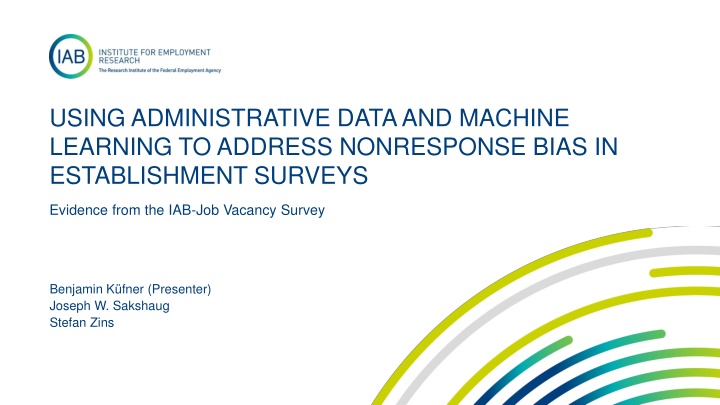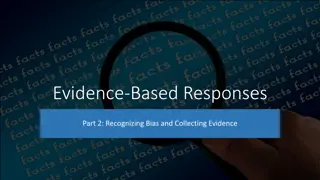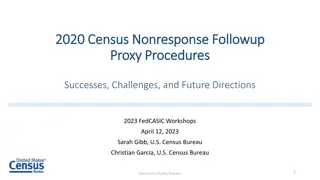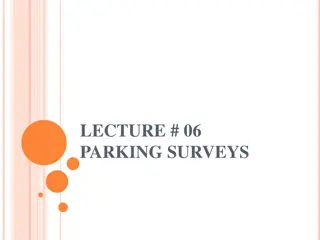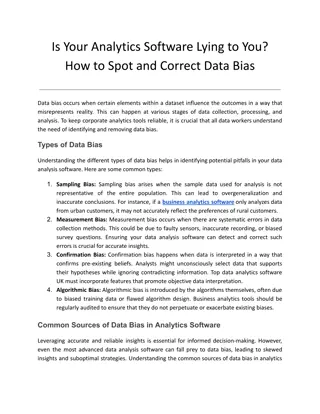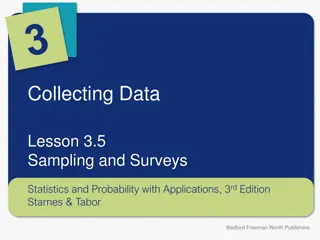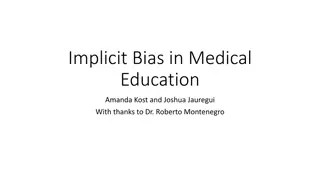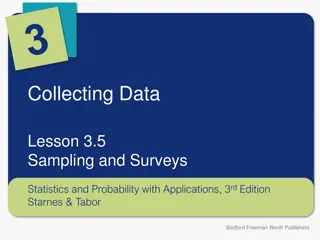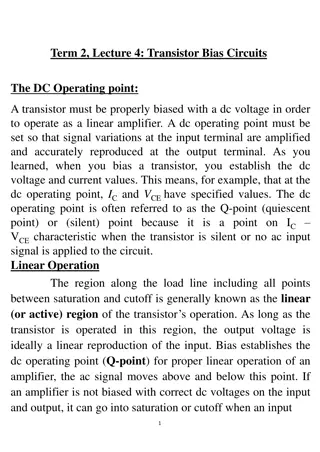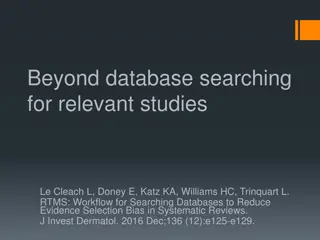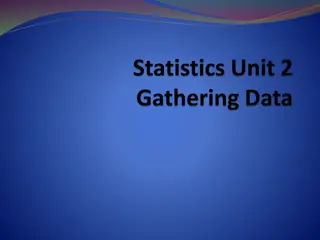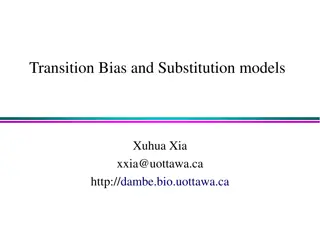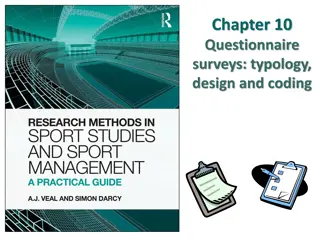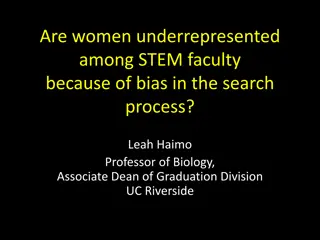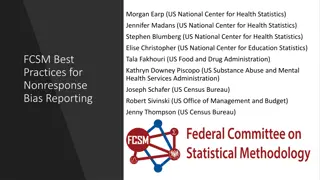Addressing Nonresponse Bias in Establishment Surveys Using Administrative Data and Machine Learning
IAB-Job Vacancy Survey faces decreasing response rates, prompting investigation into nonresponse bias with administrative data and machine learning methods. Explore how these tools can enhance survey accuracy and adjustment.
Uploaded on Feb 28, 2025 | 0 Views
Download Presentation

Please find below an Image/Link to download the presentation.
The content on the website is provided AS IS for your information and personal use only. It may not be sold, licensed, or shared on other websites without obtaining consent from the author.If you encounter any issues during the download, it is possible that the publisher has removed the file from their server.
You are allowed to download the files provided on this website for personal or commercial use, subject to the condition that they are used lawfully. All files are the property of their respective owners.
The content on the website is provided AS IS for your information and personal use only. It may not be sold, licensed, or shared on other websites without obtaining consent from the author.
E N D
Presentation Transcript
USING ADMINISTRATIVE DATA AND MACHINE LEARNING TO ADDRESS NONRESPONSE BIAS IN ESTABLISHMENT SURVEYS Evidence from the IAB-Job Vacancy Survey Benjamin K fner (Presenter) Joseph W. Sakshaug Stefan Zins
INTRODUCTION IAB-Job Vacancy Survey is facing a decreasing response rate during the last decade Risk of nonresponse bias Administrative data is getting more and more available for establishment surveys (e.g. Bavda et al. 2020) More establishment-level information on respondents and nonrespondents to analyze survey participation and nonresponse bias Growing and promising literature on machine learning in nonresponse prediction (e.g. Earp et al. 2018, Kern et al. 2019) and nonresponse adjustment (e.g. Buskirk & Kolenikov 2015, Lohr et al. 2015) Improvements of nonresponse adjustment weights due to data-driven approaches possible Research Objectives: Investigation of nonresponse bias based on administrative data Evaluation of administrative data for nonresponse adjustments Evaluation of machine-learning methods for nonresponse adjustments // Page
DATA IAB Job Vacancy Survey (Bossler et al. 2020) Annual and voluntary establishment survey conducted in the fourth quarter each year Analyzing vacancies, job flows and recruiting processes Full sample consists of up to 110,000 establishments Stratified sample (region, industry, establishment size) Establishment History Panel (BHP) (Ganzer et al. 2020) Administrative data for all establishments contributing to social security in Germany Yearly aggregation of the administrative records (reference date: 30th of June) Establishment characteristics: age, industry, establishment size etc. Employee characteristics aggregated to establishment level: age, wage, sex, qualification etc. Linkage Unique establishment identifier Due to data privacy regulations the linkage of the IAB-JVS to the BHP prior to 2010 is not possible We can link about 95 % of all sampled establishments between 2010-2018 Different reference dates between sampling frame and BHP make 100% record linkage impossible NTTS 2021 Benjamin K fner Using Administrative Data and Machine Learning to Address Nonresponse Bias in Establishment Surveys // Page 3
METHODS FOR NONRESPONSE BIAS ANALYSIS Comparing respondents and full sample with respect to administrative data Formulas: NR ???? = ??,? ??,? (1) ???.?? ???? = Avg.abs.NR bias = ??,? ??,? ? (2) ??,? ??,? ? ?=1 (3) Categorization of administrative data into equally sized categories Inclusion probabilities are considered in the estimation NTTS 2021 Benjamin K fner Using Administrative Data and Machine Learning to Address Nonresponse Bias in Establishment Surveys // Page 4
NONRESPONSE BIAS Reassuringly low level of nonresponse bias No clear trend in nonresponse bias across years Nonresponse bias with respect to establishment characteristics is higher than for employee characteristics. NTTS 2021 Benjamin K fner Using Administrative Data and Machine Learning to Address Nonresponse Bias in Establishment Surveys // Page 5
METHODS FOR NONRESPONSE ADJUSTMENTS Comparing regression and machine learning modeling approaches to estimate response propensities Regression Logistic (with and without extended set of administrative Variables) Lasso (including second term polynomials) Ridge (including second term polynomials) Generalized Additive Models (GAM) Generalized Additive Model Selection (GAMSEL) Machine-Learning: Classification and Regression Trees (CART) Conditional Inference Trees (C-Tree) Model-based recursive portioning (MOB) Random Forest Extreme Gradient Boosting (XG-BOOST) Bayesian Additive Regression Trees (BART) Weighting strategy: Response Propensity Weighting Trimming weights at the 99th percentile Multiplication of design weights (i.e. inclusion probabilities) with inverse of response propensity Evaluate nonresponse adjustment methods on two bias measures: Average absolute bias by leaving the variable out of the response propensity estimation, on which the bias is measured New Hires NTTS 2021 Benjamin K fner Using Administrative Data and Machine Learning to Address Nonresponse Bias in Establishment Surveys // Page 6
NONRESPONSE ADJUSTMENT AVG. NONRESPONSE BIAS Extended set of variables reduces nonresponse bias compared to the standard set of variables Evaluation of ML-methods: Ensemble tree methods work better than single tree-methods Regression approaches (incl. logistic regression) perform similarly to ensemble tree methods No clear winner across years NTTS 2021 Benjamin K fner Using Administrative Data and Machine Learning to Address Nonresponse Bias in Establishment Surveys // Page 7
NONRESPONSE ADJUSTMENT - NEW HIRES Similar conclusion: Extended set of administrative data improves nonresponse adjustment procedure Regression and ensemble tree methods work better than single tree methods NTTS 2021 Benjamin K fner Using Administrative Data and Machine Learning to Address Nonresponse Bias in Establishment Surveys // Page 8
CONCLUSION Response rate decreased by about 6 percentage points between 2010 and 2019 Nonresponse Bias: Nonresponse Bias is on average at a reassuringly low level No clear trend of nonresponse bias during the observation period Nonresponse adjustment: Extended set of administrative data improves nonresponse adjustments There is only limited evidence that ML-methods can help to reduce nonresponse bias compared to the standard approach Selection of variables are more important then the used method NTTS 2021 Benjamin K fner Using Administrative Data and Machine Learning to Address Nonresponse Bias in Establishment Surveys // Page 9
REFERENCES Bavda , M., Snijkers, G., Sakshaug, J. W., Brand, T., Haraldsen, G., Kurban, B., Saraiva, P. and Willimack, D. K. (2020) Business data collection methodology: Current state and future outlook. Statistical Journal of the IAOS,36, 1 16. Bossler, M., G rtzgen, N., Kubis, A., K fner, B., & Lochner, B. (2020). The IAB Job Vacancy Survey: design and research potential. Journal for Labour Market Research, 54(1), 1-12. Buskirk, T. D., & Kolenikov, S. (2015). Finding respondents in the forest: A comparison of logistic regression and random forest models for response propensity weighting and stratification. Survey Methods: Insights from the Field, 1-17. Earp, M., Toth, D., Phipps, P., & Oslund, C. (2018). Assessing nonresponse in a longitudinal establishment survey using regression trees. Journal of Official Statistics, 34(2), 463-481. Ganzer, A., Schmidtlein, L., Stegmaier, J., & Wolter, S. (2020). Establishment History Panel 1975-2018 (No. 202001_en). Institut f r Arbeitsmarkt-und Berufsforschung (IAB), N rnberg [Institute for Employment Research, Nuremberg, Germany]. Kern, C., Klausch, T., & Kreuter, F. (2019). Tree-based machine learning methods for survey research. In Survey Research Methods (Vol. 13, No. 1, pp. 73-93). Lohr, S., Hsu, V. and Montaquila, J. (2015) Using classification and regression trees to model survey nonresponse. Paper presented at Joint Statistical Meetings, Seattle. NTTS 2021 Benjamin K fner Using Administrative Data and Machine Learning to Address Nonresponse Bias in Establishment Surveys // Page
THANK YOU FOR YOUR ATTENTION! Benjamin K fner benjamin.kuefner@iab.de
